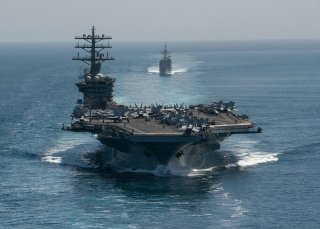Could Hypersonic Missiles Be a ‘Silver Bullet’ for Aircraft Carriers?
Experts fear that the missiles could be impossible to defend against and could reshape warfare.
Here's What You Need to Remember: Hitting the specific location of a carrier at such distance, even with a hypersonic weapon, wouldn't be the easiest thing to pull off. Current ballistic missiles that can achieve hypersonic speed follow a predictable flight path, but a concern is that these missiles could be able maneuver in unexpected ways.
Aircraft carriers have always faced seriously deadly threats. In the past, it was submarines, which long posed the most danger to carriers. Modern anti-submarine warfare (ASW) has given the advantage back to the carrier strike groups, which can better screen and protect the capital ship. While unmanned submarines could present a new problem, the greatest danger could come from hypersonic missiles.
The Russian Kinzhal is the world's first hypersonic aviation missile system, and if the claims are to be believed it has a range of 3,000 kilometers when launched from an aircraft such as the Tupolev Tu-22M3 Backfire supersonic bomber. Even if those ranges are exaggerated the platform still presents a very serious threat to U.S. warships, notably aircraft carriers.
Because of the speed at which hypersonic missiles travel the force is so significant that these can inflict damage by sheer "kinetic" impact without needing explosives. Experts fear that the missiles could be impossible to defend against and could reshape warfare. This is why some have suggested that the U.S. military invests in the technology rather than massive warships – in part because the weapons could quite easily destroy those warships.
The Japanese military is already exploring ways to develop and deploy hypersonic weapons with a special warhead that could penetrate the decks of an aircraft carrier – and it is abundantly clear that Chinese carriers could pose a serious risk to the waters around the Japanese home islands.
Carrier Killer
The Stalker Zone website recently explored a hypothetical strike on a large carrier – in this case the U.S. Navy's USS George H. W. Bush, which has a displacement of 97,000 tons and a length of 333 meters. The carrier, which has a crew of 3,200 plus 2,500 military personnel that make up the aviation wing, is quite a sizeable target for any weapon, but getting past its air defenses including its screen of destroyers would be no easy task.
Here is where a hypersonic missile could be a truly devastating game changer.
As the exercise suggested, the current characteristics of the U.S. Navy's carriers cannot counteract hypersonic missile weapons. While it might seem that a hit on the command room would be the best place to aim, the deck of the carrier may be the most effective. The mass – 500kg – of the Kh-47M2 "Kinzhal" traveling at Mach 12 would do considerable damage.
"Even if the carrier can stay afloat for the first moments after the strike, the potential of its aircraft wing will be reduced to zero by the damage caused to the deck," the Stalker Zone noted. "In addition, such a strike can lead to the defeat of at least one of the two naval Westinghouse A4W reactors. The total capacity of these reactors is 1,100 MW. A missile with a half-ton warhead moving at high speed can not only destroy the coolant circulation circuits, but also lead to the explosion of the nuclear reactors themselves during their active operation when an aircraft carrier performs a combat operation."
Such a strike from even a single hypersonic "Kinshal" missile could be enough to completely destroy an aircraft carrier but would have the potential create a chain reaction that could take out an entire carrier strike group!
Countering the Threat
Hitting the specific location of a carrier at such distance, even with a hypersonic weapon, wouldn't be the easiest thing to pull off. Current ballistic missiles that can achieve hypersonic speed follow a predictable flight path, but a concern is that these missiles could be able maneuver in unexpected ways.
Yet, it is still easy to see why there is such concern.
This is why the military is working as hard – possibly even harder – to develop counter systems to stop a hypersonic attack. Not doing so would be accepting that any nation that could acquire such weapons could devastate a fleet.
Peter Suciu is a Michigan-based writer who has contributed to more than four dozen magazines, newspapers and websites. He is the author of several books on military headgear including A Gallery of Military Headdress, which is available on Amazon.com. This first appeared earlier and is being reposted due to reader interest.
Image: Flickr.

